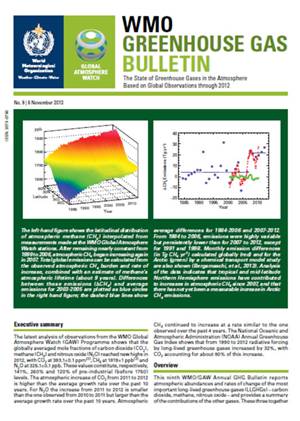CO2 Levels Hit Record High Again, “Time Is Not On Our Side”
By Countercurrents.org
07 November 2013
Countercurrents.org
 The amount of carbon dioxide in the atmosphere has risen to a record high – again, says the World Metereological Organisation.
The amount of carbon dioxide in the atmosphere has risen to a record high – again, says the World Metereological Organisation.
For the past nine years the WMO has produced an annual bulletin, the Greenhouse Gas Bulletin, with each year notching up a record high for average annual levels, and figures published on November 6, 2013 show 2012 was no exception.
The current WMO bulletin (The State of Greenhouse Gases in the Atmosphere, Based on Global Observations through 2012, No. 9) shows that GHGs are heating the climate more and more every year. The rate of increase appears to be accelerating, too. 2012 was already above average for the last decade, but 2013's rate of increase looks almost certain to be higher still.
The bulletins report the latest trends and atmospheric burdens of the most influential, long-lived greenhouse gases (LLGHG); carbon dioxide (CO2), methane (CH4), and nitrous oxide (N2O), as well as a summary of the contributions of the lesser gases.
The bulletins represent the consensus of a consortium of networks operated since the mid- 1980s. These three major gases alone contribute about 88% of the increase in radiative forcing of the atmosphere by changes in LLGHG occurring since the beginning of the industrial age (since 1750).
The bulletin shows that between 1990 and 2012, there was a 32 per cent increase in radiative forcing – the warming effect on the climate – because of carbon dioxide (CO 2 ) and other heat-trapping long-lived gases such as methane and nitrous oxide. Carbon dioxide, mainly from fossil fuel-related emissions, accounted for 80 per cent of this increase, WMO stated in a news release.
It should be mentioned that:
A UNEP report showed on November 5, annual worldwide emissions from power plants, cars and other human activities are currently several billion tonnes too high to keep temperatures rises below 2C, the 'safe' level governments have agreed to limit rises to.
In September, the IPCC told atmospheric CO2 concentrations were at levels "unprecedented in at least the last 800,000 years."
In May this year, CO2 levels briefly passed the symbolic milestone of 400 parts per million (ppm), considerably higher than the average for 2012 of 393.1ppm.
The latest analysis of observations from the WMO Global Atmosphere Watch (GAW) Programme shows that the globally averaged mole fractions of carbon dioxide (CO2), methane (CH4) and nitrous oxide (N2O) reached new highs in 2012, with CO2 at 393.1±0.1 ppm, CH4 at 1819±1 ppb and N2O at 325.1±0.1 ppb. These values constitute, respectively, 141%, 260% and 120% of pre-industrial (before 1750) levels. The atmospheric increase of CO2 from 2011 to 2012 is higher than the average growth rate over the past 10 years. For N2O the increase from 2011 to 2012 is smaller than the one observed from 2010 to 2011 but larger than the average growth rate over the past 10 years. Atmospheric CH4 continued to increase at a rate similar to the one observed over the past 4 years.
It said:
Atmospheric CO2 reached 141% of the pre-industrial level in 2012, primarily because of emissions from combustion of fossil fuels, deforestation and other land-use change.
“As a result of this, our climate is changing, our weather is more extreme, ice sheets and glaciers are melting and sea levels are rising,” said WMO Secretary-General Michel Jarraud.
“According to the IPCC, if we continue with ‘business as usual,' global average temperatures may be 4.6 degrees higher by the end of the century than pre-industrial levels – and even higher in some parts of the world. This would have devastating consequences.”
He added: “Limiting climate change will require large and sustained reductions of greenhouse gas emissions. We need to act now, otherwise we will jeopardize the future of our children, grandchildren and many future generations.
“Time is not on our side.”
.
Comments are moderated
